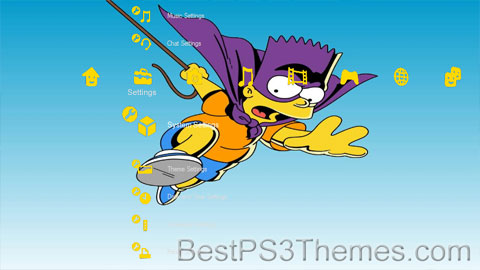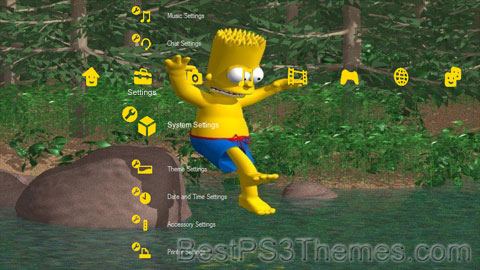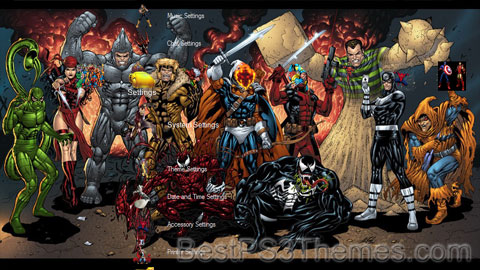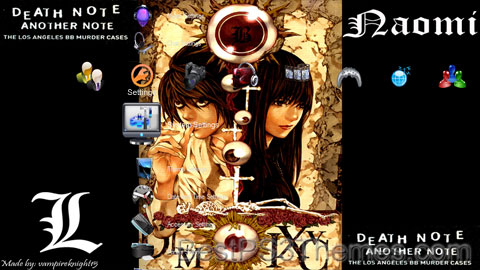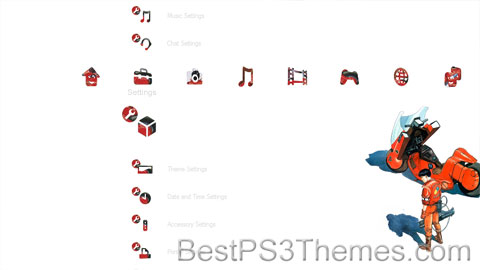Zoids theme by Ed
Download: Zoids.p3t
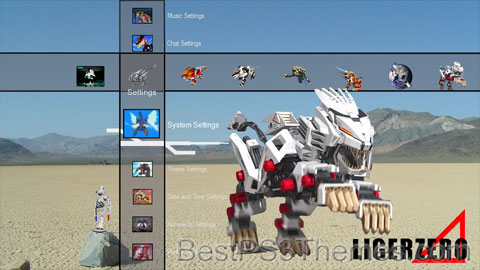
(3 backgrounds)
| Zoids | |
|---|---|
| Created by | Tomy |
| Original work | Japan |
| Owner | Tomy |
| Years | 1983–present |
| Print publications | |
| Comics | Spider-Man and Zoids #1–51 (1986–87)[1] |
| Films and television | |
| Animated series | |
| Games | |
| Traditional | Zoids action figures |
Technozoids (テクノゾイド, Tekunozoido), also referred to as simply Zoids (ゾイド, Zoido), is a Japanese science fiction media franchise created by Tomy that feature giant robots (or "mecha") called Technozoidaryans, otherwise known as Technozoids, Zoidaryans or Zoids for short. A Zoid is essentially a large mechanical animal, with designs being based on animals; including dinosaurs, insects, arachnids and mythological creatures.
The franchise started with a plamo kit line and includes five main anime TV series (Chaotic Century, New Century, Fuzors, Genesis and Wild) as well as several video games and manga products.[2]
Model kit lines[edit]
There have been a number of different Zoids model lines over the years, both in Japan and other countries. Between these lines, over 200 different designs have been released, some several times over. Several companies outside of Takara-Tomy have produced Zoids kits. This has led to Zoids being made as die-cast figures, highly detailed posing kits, smaller action figures and even PVC figurines.
Mechabonica[edit]
The predecessors to Zoids. Released in 1982, "Mechabonica" was technically not a Zoids line, but is counted as such by collectors as it consisted of three models that would later be re-released as the first three Zoids (Garius, Elephantus, and Glidoler). The line was not very successful and was quickly dropped by Tomy.
Starzeta[edit]
Starzeta was the Spanish version of the Mechabonica line. Since Tomy had no direct marketing power in Spain during the 80s the models were released under licence by a smaller company (Feber) but unfortunately the line performed even worse than its Japanese counterpart. The same 3 models were released but bizarrely they were given new color schemes; grey parts became silver and the dark blue caps became bright blue. The models were not given names but are listed as Starzeta I, II and III.
SZ IV (Garantula), SZ V (Aquadon) and SZ VI (Gorgodos) were supposedly planned as a continuation of the series but their release status is currently unknown.
The models are incredibly rare (even more so than the Japanese Mechabonica) and demand is boosted even further by their unique color schemes.
Original American release[edit]
TOMY sold the Mechabonica line in the United States and Europe in late 1982, under the name Zoids. The line was far more successful than Mechabonica, which led TOMY to reintroduce the line in Japan under the new name.
Later, a pair of original Zoids, the Power Zoids Tank and Serpent, were created exclusively for the European and North American markets and were never released in Japan. Other Zoids like the Bigasaur (renamed to Giant ZRK) were also released. Radio Shack released the Mammoth Zoid in the US at the same time. While not a part of the release, it is generally counted with them. The Original American Release is commonly abbreviated as OAR by fans and collectors.
Original Japanese Release[edit]
In 1983, following the success of the OAR, TOMY reintroduced the Zoids line in Japan. The relaunched Japanese line, now entitled Zoids, was a success, running from 1983 until 1990. The Zoids line had its own "Battle Story" that was told serially on the backs of the model boxes and in catalogues.
Initially, the Zoids were divided into two distinct factions, the Helic Republic and the Zenebas Empire. In 1989, the Zenebas Empire was replaced with the Guylos Empire.
The Original Japanese Release is commonly abbreviated as OJR.
Original European Release[edit]
Zoids were also released in Europe, (and to a limited extent in Australia, South Africa and South-East Asia), from 1984 to 1987 by TOMY. The models in this release were a mixture of ones directly ported over from the OJR, as well as recolored Zoids, including the rare Ghost Zoids line. Additionally, the Tank and Serpent Power Zoids from the OAR were released. Most of the Zoids in the line were renamed.
The Zoids in the release were divided into two distinct factions, which are the Blue Guardians and the Red Mutants. The line had its own story told in the UK Zoids comic.
The Original European Release is commonly abbreviated as OER.
Robo Strux[edit]
Robo Strux were released in the US and Canada by TOMY, in 1985–86. All the Zoids in the line were OJR Zoids, however, some versions of the same model retained their original (OJR) color scheme, whereas other versions of the same model received a distinctive Robo Strux color scheme. Thus, the Robo Strux line had two differently colored releases of several models. Based on their color schemes, the Zoids were divided into two factions, the heroic Blue Guardians and the evil Red Mutants. However, there was no accompanying story or media.
Due to the lack of marketing and the relatively high prices of the models, Robostrux was rather short-lived.
Robostrux is commonly abbreviated as RS.
1:24 Scale Zoids[edit]
In 1988, TOMY launched a sub-line of the OJR, featuring larger-scale Zoids. The 1:24 line featured Zoids of similar size to existing ones, but scaled for larger pilots. Each kit came with a 3 inch tall action figure of the pilot. Like the regular Zoids line, the Zoids were divided into Helic and Zenebas factions.
The 1:24 Zoids were not a success, and were discontinued after a year.
Zevle[edit]
In 1990, TOMY re-released several of the 1:24 scale Zoids in a new line called Zevle. The Zoids were recolored from the OJR versions, and came with detailed, 3 inch tall action figures of the pilot and crew. The pilot figures were unpainted and on sprues, much like a model kit, and had to be assembled. The crew figures also came with accessories of guns and beam sabers. Zevle featured its own "Battle Story" on the boxes, but while it was similar to the Zoids Battle Story, it was unrelated to it.
Like the 1/24th Zoids, Zevle was a commercial failure and was discontinued.
Technozoids[edit]
Kenner acquired the rights to release Zoids in North America, releasing the Technozoids line in 1995–1996. The Zoids in the line were all recolors of earlier Zoids released in the OJR, although some were directly imported from the Zoids2 line. There were no distinct factions for the Zoids, and no backstory was given.
The Technozoids line was a failure and was discontinued after one year. A number of Zoids were left unreleased at the end of the line.
Technozoids is commonly abbreviated as TZ.
Zoids 2[edit]
TOMY released another line of Zoids in the UK and Europe (with a re-release in Australia and South-East Asia) in 1994. The Zoids 2 line featured very bright color schemes, with all the Zoids having at least some chromed parts. The Zoids also had unique stickers with odd swirling designs. The Zoids 2 line did not feature distinctive factions for the Zoids, but did have a backstory loosely based on (but not a continuation of) the UK Zoid comic, with the Zoids invading Earth and humanity's last hope being to turn the Zoids against each other.
Like Technozoids, Zoids 2 was eventually discontinued.
Zoids 2 is commonly abbreviated as Z2.
New Japanese Release[edit]
In 1999, TOMY relaunched the Zoids line in Japan, with subsequent releases elsewhere in Asia. Initially, the line consisted of recolored re-releases of older Zoids, but TOMY quickly began producing new Zoids designs. The Zoids were divided into Helic and Guylos factions, with the Zenebas Empire returning later. The OJR battle story was continued on the NJR boxes, with the Zoids Anime and Manga drawing on alternate versions of the New Battle Story's events.
The line was abruptly discontinued in August 2004. By the end of the line, there were still thirty-three Zoids from the OJR line that had yet to be re-released.
The New Japanese Release is unofficially abbreviated as NJR.
Customise Parts[edit]
Along with the re-launch of the Zoids line, TOMY also launched a line known as Customise Parts or simply CP. The line consisted of additional weapons and equipment that could be added onto Zoids models. The line was a mixture of new parts and re-issues of parts originally included in various OJR models (as well as the Empire and Republic Customization Kits).
The Customise Parts line was discontinued in 2002.
Blox[edit]
In 2002, TOMY introduced a new line of non-motorised Zoids called Blox, which featured flexible construction. Blox Zoids can be easily disassembled and combined with each other, as well as with regular Zoids.
Toys Dream Project[edit]
In 2002, Toys Dream Project began a line of limited Zoids releases. The line consisted of a mixture of new recolors of existing Zoids and re-releases of older versions of some Zoids in their OJR colors, as well as kits paired with uniquely colored customize parts.
Zoids: Build Customize Mobilize[edit]
Following the launch of the NJR, Hasbro licensed Zoids for release in North America and South-East Asia in 2001. Like the NJR, the line was divided into Republic and Empire factions, with the Anime providing the backstory. Initially, the Hasbro line consisted of just re-releases of Zoids from the NJR. However, they later began developing their own Zoid designs, as well as co-developing others with TOMY. Additionally, Hasbro had planned to re-release several OJR Zoids that had not been released in the NJR.
Although it was initially successful, Hasbro suspended the line in 2004, due to poor sales. The cancellation of the line left a number of new Zoids unreleased, including most of those not yet re-released by TOMY. Much of the leftover stock was later released by Hasbro in Australia and the UK.
In Australia and South-East Asia, these Zoids were released by TOMY. These countries were identical to Hasbro's Zoids, but featured TOMY branding on the box. In the UK the Zoids boxes featured slightly different logos to both Australia and the US. The UK release featured several Zoids designs and color schemes that were not available in the US.
Z-Builders[edit]
Any Blox Zoids that were released by Hasbro were sold as part of the line known as Z-Builders. Most of the Z-Builders were re-releases of the NJR Blox line, but the line included several Hasbro-designed Zoids, as well as individual releases of Blox Zoids that did not occur in Japan. The Z-Builders line was suspended alongside the motorized models. Z-Builders was released in Australia and the Pacific featuring TOMY branding instead of Hasbro branding.
Fuzors[edit]
In late 2004, TOMY launched a new Zoids line to tie into the Zoids: Fuzors anime that was then showing on Japanese TV. The line was composed entirely of recolors of older Blox and Zoids. Some models were altered slightly, or packaged with additional parts, mainly to allow different Zoids to connect (or "fuse"). The line also featured a number of Zoids that were previously only released in North America.
The line was abruptly halted in early 2005, with several items unreleased.
Fuzors is commonly abbreviated as FZ.
Genesis[edit]
In early 2005, another new Zoid line was launched, to tie into the Zoids: Genesis anime. The line consists of a mixture of old designs, new designs and older designs with new parts. The line is most notable for the much-anticipated reissues of Houndsoldier and Gilvader.
Reactions to the line were mixed; the re-releases of older designs (which included several OJR Zoids not previously re-released) were well received. The new designs, namely the Bio-Zoids which had rubber armor, did not do so well, having been plagued by quality control issues and production errors.
Genesis is commonly abbreviated as GZ. An alternate abbreviation, GB, is used for the Bio-Zoids released as part of this line.
Neo-Blox[edit]
Released in May 2006, the Neo-Blox are an improvement on the previous Blox line, primarily due to the greater range of poseability the 'Blox and peg' connection system has.
Two sublines have also been released. The first is the Legends Series, which features Zoids from previous releases, but redesigned to be the same size as the Neo-Blox Zoids, and modified to use the same connector system. The second are the Custom Blox; subline appeared to be on hold, with Tomy instead focusing on the Legend Blox sub-line. With the cancellation of all unreleased Neo-Blox in early 2007, the line was effectively dead.
The Neo-Blox is abbreviated as either NBZ or NB. Alternate abbreviations are used for the Legends Series (LB) and the Custom Blox (CBZ).
Academy Zoids[edit]
Academy, a company from Korea better known for model airplanes and ships, re-released many of the NJR Zoid models, as well as some Zoids from the Customize Parts, Fuzors and Genesis series. In most cases, these Academy Zoids have nearly identical packaging to their Japanese predecessors save for the Korean language and a sticker bearing the Academy logo. Though the quality of the Academy Zoids were on par with their Japanese counterparts in the early 2000s, the age and repeated use of some molds, such as Command Wolf and Liger Zero, has caused degradation in the line. The line continues to sell Zoids exclusively in Korean markets.
High-end Master Model[edit]
Starting in late 2006, the High-end Master Model line, commonly abbreviated HMM, is a joint effort between Tomy and Kotobukiya. The line advertises high-quality, highly detailed, pose-able model kits based on designs of existing Zoids.
Evo Drive Zoids[edit]
Miniature Zoids Starting in late 2006, the High-end Master Model line, commonly abbreviated HMM, is a joint effort between Tomy and Kotobukiya. The line advertises high-quality, highly detailed, pose-able model kits based on designs of existing Zoids.
Zoids Graphics[edit]
Released in Summer 2007 onward, the Graphics line are reissues of the OJR model kits released in the 1980s. They feature the model kit in special windowed packaging along with bonus parts or miniature figures and a booklet with early battle story information.
Zoids 25th: Rebirth Century[edit]
Starting in 2008 as part of the line's 25th anniversary, this new Zoids line contains both re-releases of 80s Zoids and entirely new designs. The backstory is set between the end of the original line and the start of the new Japanese release, covering the Zoidians' efforts to rebuild after the meteor disaster and the conflicts that come with it.
Zoids Anime 10th Anniversary[edit]
Starting in 2009, as a tribute to both the NJR Zoids Release and the Chaotic Century Anime series, the Anime 10th Anniversary is a limited line of correctly colored model kits based on those piloted by characters in the Anime series. The line abruptly stopped after just two of the kits were released. Zoids: Chaotic Century is what this 10th anniversary is based upon. It was only ended in 1999.
Revoltech Zoids[edit]
A company called Kaiyodo released four Zoids as Revoltech figures under the Yamaguchi line. Two Zoid types, the Blade Liger and the Geno Breaker, were produced with the Liger coming in three different colors. These Zoids were made to be highly pose-able, having more joints than any Revoltech before. These Zoids are smaller than the motorized Zoid models but larger than the Hasbro action figures.
Yamato Zoids[edit]
Yamato released two Shield Ligers and a set of Beam-Cannons for the Zoids between 2010 and 2012. These Zoids had die-cast metal parts as well as fine details and many points of articulation for movable parts. The action models dwarfed their predecessors in size and weight. The first Shield Liger was colored like the hero Zoid of the Chaotic Century series and included three small character figures. The second was painted black and silver and included the Beam Cannon like the limited NJR model, the Shield Liger DCS-J, it was based on. The Yamato Shield Liger was released in the United States and is the only line to be sold in the U.S. since Z-Builders.
Modeler's Spirit Series[edit]
For the 30th anniversary of Tomy's main Zoids line, the franchise was treated to a new line of Zoids kits. Abbreviated MSS, the Modeler's Spirit Series were produced by TOMYTEC at a 1:144 scale, much smaller than previous lines. These Zoids are not motorized but do feature posing gimmicks similar to Mobile Suit models, which have used the word 'gimmick' for movable parts longer. Zoids in the MSS line also include a display base. The first MSS Zoids, released in January 2013, were a Shield Liger and Hammer Rock.
Zoids Original[edit]
Another event for the 30th anniversary was announced on Takara-Tomy's main Zoids web page. Titled Zoids Original, the line features redesigned motorized kits. As with other core Zoids lines, the new series includes a tie-in Battle Story. A model called the Mirage Fox was the first kit to be released in the new line.
Battle story[edit]
"Battle story" is a fictitious timeline of events that features on the boxes, manuals and cataloges of some Zoid model kits. Battle Story allows collectors to piece together information about the Zoids universe from the perspective of certain Zoids, and their roles in the various timelines. None of the English-language model kits feature this story.
Original battle story[edit]
Beginning fairly early after the start of the original Japanese Zoid releases, the battle story first introduced the conflict between two rival nations: the Helic Republic and Zenebas Empire. Their main weapons were Zoids, living war machines built from metal-based lifeforms native to planet Zi. The Zenebas Zoids were mostly red and silver and more armored, the Helic more skeletal and favoring blue and grey.[3]
The line expanded and drew in fans, and was thus given a proper ongoing story, with the creators wanting to appeal to fans of science fiction and animation.[4] The two nations' conflict turned into an ongoing series of stories included on the boxes and published in various magazines and books.[5][6] History of Zoids, published in 1985, covered Zi's history as a planet wrecked by natural disasters and conflict, King Helic's uniting the original tribes and formation of the Republic, the Empire's bitter splitting off after his son Helic II took over and the younger Zenebas was betrayed by the era's politicians, and much of the earlier battles in the resulting war over territory on the Central Continent.[7][8]
As more advanced model kits were added to the line, a human element was added to the story: mainly, a ship from Earth (the Globally 3) crashlanding on Zi. Earth technology made its way to both sides, accelerating the arms race and making for many stronger Zoids.
In 1986, the Ultrasaurus was released, and billed in-story as the machine that would defeat the Empire. It nearly succeeded, but Zenebas and his forces fled to the Dark Continent Nyx, soon returning with new-model Zoids like the Death Saurer. The Republic was driven back and forced to hold the Empire off with guerrilla warfare in the mountains, paving the way for the brief 1/24 scale line (notable for featuring the Battle Rover as the winner of a fan design contest).[9] The Republic's counterattack came in the form of the Mad Thunder, and as Zenebas again turned to the Dark Continent for help, he was betrayed by Guylos, whose new "Dark Army" Zoids[10] attacked and absorbed the Empire Army.
1989 thus marked a drastic change in the line's focus, the first catalogue even calling it "Zoids New Century"[11] (a title unrelated to the anime series Zoids New Century /Zero). The more ambiguous conflict became more "good versus evil", with Guylos described as having a "merciless, cruel fighting style [...] beyond imagination" in Tomy's material,[12] and Shogakukan's version of the battle story abandoning telling things from both sides to give only the viewpoint of a Republic soldier portrayed as a hero. There were no windup kits released after the Cannonfort in April 1989, the toys instead focusing on "Gradeups", curvy techno-organic designs with vacuum metalized parts, build-it-yourself motor boxes, and interchangeable custom parts.[13]
The line ended in the late months of 1990, King Gojulas and Descat marking the final designs.[14] Battle story Zi came down to a final showdown between the nigh-unstoppable King Gojulas and various Dark Army Zoids (including Gilvader), only to have the conflict cut short as a comet struck Zi's third moon, raining down meteor destruction and leaving the entire planet in disarray.[15]
New battle story[edit]
The Zoids revival in 1999 included both an anime[16] and a new battle story. After decades of peace, the current Emperor died, leaving only the young Rudolph as his heir. His regent, Prozen, took the opportunity to resume the conflict between the Guylos Empire and the Republic. Early on, both sides used their past Zoids, the model line focusing entirely on reissues of popular past kits.[17]
As technology advanced, entirely new designs were produced, the first being the Rev Raptor and Geno Saurer.[18] Many of them were also tie ins to the Chaotic Century anime, including special pilot figures of characters who used them while the Zoids did different things in the battle story.[19] The accelerating arms race came to a head with the Death Stinger, which proved an uncontrollable berserker and only served to further the Guylos Empire's gradual loss.
Their retreat to the Dark Continent was not as it seemed, and in 2004 (four years after the first anime series finished its run), Prozen was revealed to be Zenebas' son...and the current ruler of the Republic his daughter under the alias Louise Elena Camford. The entire war until now had been a ruse to weaken both nations, and in a bitter coup ending with his own death Prozen engineered the rise of Neo Zenebas. His son took over the reins, driving the Republic forces back to the Eastern Continent.
The toyline shifted to match, introducing the new posable "Blox" kits (first sold in 2002)[20][21] as the creation of humans who had fled there to remain neutral in the original conflict. They sold their work to both sides during the Republic's bid to regain their homeland. The ensuing battles—and the battle story portion of the toyline—ended with the Republic reclaiming their capital, forcing the Zenebas Empire back to the western half of the Central Continent.[22]
Three Tigers[edit]
Providing a glimpse into Zi's future and released in 2004,[23] the Three Tigers line consisted of all of six kits: three legendary Tiger-type Zoids (one formed via a combination of two separate kits) and the Dekalt Dragon (also a combination). It was very closely followed by the Fuzors line and its direct anime tie-in (also in 2004),[24] and featured a similar setting: Zoids are owned mainly by private citizens, with fightworthy ones restricted to peacekeeping forces and licensed sports battlers.[25]
Two large Zoid manufacturing corporations, ZOITEC and Zi-Arms, became considerable powers on Zi. Discovering the cores of ancient tiger Zoids, they set out to create their own versions. Part of Zi-Arms proved to have an ulterior motive: seizing power and reviving the glory days of the Empire with the Dekalt Dragon, Brastle Tiger, and a Mega Death Saurer. The two ZOITEC Tigers (Whitz and Rayse) team up with a rebelling Brastle to stop the Saurer, however ... and then vanish, the story booklet included with the Brastle Tiger kit describing them as "disappearing back into legend".
Rebirth Century[edit]
While the old battle story and the 1999 revival left nearly thirty years post meteor disaster undetailed, Tomy's Rebirth Century revival[26] (2008–2010) picks up where the old story left off. After retelling the final battle with King Gojulas, it moves on to a Zi torn by magnetic storms and faction tensions, using it as a reason to rerelease both old kits (Gilvader and King Gojulas included)[27] and new designs.
Onslaught[edit]
For the 30th anniversary of the OJR line, Takara-Tomy revived the Battle Story on the main Zoids website. Prior to the anniversary, this story was released as a book series titled Zoids Concept Art in 2010. Though the overall plot is the same, some differences between the OJR and the Onslaught version occur. Also, the new version of the Battle Story is digitally illustrated with highly stylized Zoids instead of featuring pictures of the actual Zoids models like the older lines did. Episodes of this story can be viewed on the Tomy's main Zoids web page.
Anime[edit]
The six anime series pertaining to Zoids are: Zoids: Chaotic Century and its sequel series Zoids: Guardian Force, Zoids: New Century Zero, Zoids: Fuzors, Zoids: Genesis, and Zoids Wild. The first four series take place on the fictitious planet Zi. Zoids Wild is set on a post-apocalyptic version of Earth. Chaotic Century and Guardian Force aired as one series in the US, but they are considered two separate series by Takara Tomy.
Chaotic Century (1999)[edit]
Zoids: Chaotic Century is the first two Zoids anime series and consists of Chaotic Century and Guardian Force. Its setting is loosely based on that of Battle Story, and follows Van Flyheight as he meets an amnesiac girl called Fiona and an organoid called Zeke. As the series progresses, Van meets various opponents, such as Raven, and friends, like Moonbay and Irvine, and eventually ends up helping Fiona in her quest to regain her memory and to find a mysterious entity called the "Zoid Eve". Their quest takes them into the thick of an ongoing war between the two factions of the Helic Republic and the Guylos Empire.
In the US the story of Chaotic Century is split into two seasons, with a time skip in the middle. In Japan Guardian Force is considered the second series. Three to four years after the initial arc ("Chaotic Century"), the second story (Guardian Force) begins. The two warring nations seen in the first arc have made peace, and to ensure it remains, they establish a joint military task force called the Guardian Force. Van becomes a part of this force, and after some time again goes searching for the elusive Zoid Eve. On the way, he meets up with both old and new friends and foes.
Despite being the first series created in Japan, Chaotic Century was the second series to be broadcast in English, following New Century.
As well as the anime series, there was a Chaotic Century manga published in Japan. It was later reproduced in English in North America by Viz Communications, and in Singapore in English by Chuang Yi. There are significant differences between the anime and manga, becoming more striking in the later issues.
New Century (2001)[edit]
Zoids: New Century takes place some time after the events of Guardian Force, however, aside from a few cameo appearances, there is no direct relation to the past series. In New Century Zoid battles have become a tournament-based fighting competition. The main character is Bit Cloud, a junk dealer, who forms part of the Blitz Team. He becomes a pilot of their Zoid, the Liger Zero, a temperamental Zoid that previously had been unpilotable. Bit and Liger form a partnership and end up joining the Blitz Team in their various league matches. He is aided by his teammates, Leena Toros, Brad Hunter, Jamie Hemeros, as well as their leader, Dr. Steve Toros.
Along the way, Bit's unique Zoid gets the attention of the Backdraft Group, an organization who is trying to take over Zoid battles and make them more "interesting" by using illicit battles, often with no rules or regard to pilot safety. The Backdraft attempts to acquire the Liger Zero by any means possible.
New Century Zero has a number of animation cameos with Zoids from Chaotic Century and Guardian Force, which are the cause of much fan speculation but not explained. Moonbay's Gustav can be seen in the background in one of the later episodes, the Backdraft shoots judge satellites down with a Death Stinger tail, the Death Saurer appearing as a model and in a background TV show, the three Geno Saurers that attack Berserk Fury, and the Ultrasaurus wreck on which Bit Cloud claims victory carries the Gravity Cannon on its side.
This was the first Zoids series to appear on American television, airing in Cartoon Network's Toonami block.
Fuzors (2003)[edit]
Zoids: Fuzors follows the adventures of team Mach Storm and RD, a novice Liger Zero pilot. They live in the technologically advanced Blue City, competing in Zoid battles.[28] When a top team is wiped out by a pair of Zoids able to combine, it leads to a series of discoveries relating to special "Fuzor" Zoids and combinations: RD's Liger Zero ends up partnered with the Fire Phoenix and later the Jet Falcon.
There's something more sinister lurking behind the sports battles and RD's rivalry with team Savage Hammer. As the series unfolds RD and his friends Helmut, Sigma, Hop, Sweet and Matt get caught up in a plot to take over the city. Eventually RD discovers the secret behind the mysterious "Alpha Zoid" and with the help of pilots from all over the city, defeats the Seismosaurus holding it under siege.
About half-way through the series, the show was removed from America's Cartoon Network, ending on a cliffhanger. This was most likely a result of flagging ratings and toy sales, although its timeslot did not help matters. However, the full series aired in Australia and was later shown in Japan, getting full DVD releases in both countries.
Genesis (2005)[edit]
Zoids: Genesis aired in 2005. At a certain point in time, there was a great quake on Planet Zi. An enormous crack ran through the planet, stretching as far as the seabeds to the high mountains. Volcanoes erupted with fire, and the sky was covered in darkness. Many cities were destroyed as they were swallowed in large areas, sinking underwater. This was known as "God's Fury."
Before this large series of natural disasters, all civilizations were at their peak. All were destroyed by the disasters, and it was several thousand years before the inhabitants of Zi were able to re-establish themselves in any meaningful form. Survivors of the disasters gathered together and formed new civilizations; these groups searched for Zoids that are buried underground for human use.
The story begins in a village whose most precious item, a giant blade, is worshipped as a holy symbol. Ruuji, a teenage boy, discovers an ancient Liger-type Zoid, the Murasame Liger, while on a deep water salvage operation. His village is suddenly attacked by skeletal "Bio-Zoids" intent on securing the powerful Generator located in the village. During the attack, Ruuji awakens Murasame Liger and fends off the Bio-Zoids, however the Generator on which the village depends becomes damaged in subsequent attacks. Seeking to repair it, Ruuji sets off on a journey to find a mechanic capable of fixing a generator.
Wild (2018)[edit]
Zoids Wild is the newest Zoids anime series. It began airing on July 7, 2018 on Mainichi Broadcasting System and Tokyo Broadcasting System. It is notable that characters are depicted riding on top of Zoids rather than within an enclosed cockpit as in previous Zoids media.[29]
UK Zoids comics[edit]
In the 1980s, a Zoids tie-in strip was published in the Marvel UK title Secret Wars.[30] On the back of this, it gained its own weekly title, Spider-Man and Zoids. This story has no continuity with any Japanese anime (which didn't exist at the time) and it was created to go along with the original UK (and subsequently Australian) release of model kits. The comic is notable for featuring early work by Grant Morrison, including the epic and apocalyptic Black Zoid storyline.
References[edit]
- ^ Spider-Man and Zoids index at the GCD
- ^
South Park 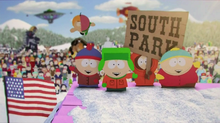
Genre Created by Developed by Brian Graden Showrunners - Trey Parker
- Matt Stone
Voices of - Trey Parker
- Matt Stone
- Mary Kay Bergman
- Isaac Hayes
- Eliza Schneider
- Mona Marshall
- April Stewart
- Adrien Beard
Theme music composer Primus Composers - Adam Berry
- Scott Nickoley
- Jamie Dunlap
Country of origin United States Original language English No. of seasons 26 No. of episodes 328 (list of episodes) Production Executive producers - Trey Parker
- Matt Stone
- Brian Graden
- Deborah Liebling
- Frank C. Agnone II
- Bruce Howell
- Anne Garefino
Producers - Vernon Chatman
- Eric Stough
- Bruce Howell
- Adrien Beard
- Jack Shih
Cinematography Kenny Gioseffi Running time 22 minutes[1] Production companies - Celluloid Studios (1997)
- Braniff Productions (1997–2006)
- Parker-Stone Productions (2006–2007)
- South Park Studios (2007–present)
- Comedy Partners
Original release Network Comedy Central[nb 1] Release August 13, 1997 –
presentRelated The Spirit of Christmas South Park is an American animated sitcom created by Trey Parker and Matt Stone and developed by Brian Graden for Comedy Central. The series revolves around four boys—Stan Marsh, Kyle Broflovski, Eric Cartman, and Kenny McCormick—and their exploits in and around the titular Colorado town. South Park also features many recurring characters. The series became infamous for its profanity and dark, surreal humor that satirizes a large range of subject matter.
Parker and Stone developed South Park from two animated short films, both titled The Spirit of Christmas, released in 1992 and 1995. The second short became one of the first Internet viral videos, leading to the series' production. The pilot episode was produced using cutout animation; the remainder of the series uses computer animation recalling the prior technique. Since the fourth season, episodes are generally written and produced during the week preceding its broadcast, with Parker serving as the lead writer and director.
Since its debut on August 13, 1997, 328 episodes of South Park have been broadcast. It debuted with great success, consistently earning the highest ratings of any basic cable program. Subsequent ratings have varied, but it remains one of Comedy Central's longest-running programs. In August 2021, South Park was renewed through 2027, and a series of television specials was announced for Paramount+, the first two of which were released later that year.[2][3] In October 2019, it was announced that WarnerMedia acquired exclusive streaming rights to South Park starting in June 2020 for HBO Max.[4] The series' twenty-sixth season premiered on February 8, 2023.[5]
South Park has received critical acclaim, and is included in various publications' lists of the greatest television shows. It has received numerous accolades, including five Primetime Emmy Awards and a Peabody Award. A theatrical film, South Park: Bigger, Longer & Uncut, was released in June 1999 to commercial and critical success, garnering an Academy Award nomination. In 2013, TV Guide ranked South Park the tenth Greatest TV Cartoon of All Time.[6]
Premise[edit]
Setting and characters[edit]
South Park centers around four boys: Stan Marsh, Kyle Broflovski, Eric Cartman and Kenny McCormick. The boys live in the fictional small town of South Park, located within the real-life South Park basin in the Rocky Mountains of central Colorado,[7] approximately a one-hour drive from Denver.[8] The town is also home to an assortment of other characters, including students, families, elementary school staff, and other various residents.[9] Prominent settings include South Park Elementary, various neighborhoods and the surrounding mountain range, actual Colorado landmarks, and the businesses along the town's main street, all of which are based on the appearance of similar locations in Fairplay, Colorado.[7][9] As one of the few television programs set in the Mountain West region that takes place outside the urban core of Denver, South Park frequently features the unique culture of the region, including cattle ranchers, Old West theme parks, snowy climates, mountaineering, Mormons, real-life Colorado locations such as Casa Bonita and Cave of the Winds, and many other regionally specific characteristics.
Stan is portrayed as an average American boy; however, he has many mishaps throughout the series. In the first 22 seasons, Stan lived in South Park, but in the episodes during and after season 22, Stan resided in Tegridy Farms. Kyle is Jewish, and his portrayal as one of the few such people in South Park is often dealt with satirically.[10] Stan is modeled after Parker, while Kyle is modeled after Stone. They are best friends, and their friendship, symbolically intended to reflect Parker and Stone's friendship,[11] is a common topic throughout the series. Cartman (as he is commonly referred to) is amoral and increasingly psychopathic, and is commonly portrayed as an antagonist. His staunch antisemitism has resulted in a progressive rivalry with Kyle.[10][12] Kenny, who comes from a poor family, tightly wears his parka hood to the point where it obscures most of his face and muffles his speech. During the first five seasons, Kenny died in almost every episode before reappearing in the next with no definite explanation. He was killed off in the fifth season episode "Kenny Dies", before being reintroduced in the sixth season finale, "Red Sleigh Down". Since then, Kenny is depicted as dying sporadically. During the first 58 episodes, the children were in the third grade. During the fourth season, they entered the fourth grade, where they have remained ever since.[13][14]
Plots are often set in motion by events, ranging from the fairly typical to the supernatural and extraordinary, which frequently happen in the town.[15] The boys often act as the voice of reason when these events cause panic or incongruous behavior among the adult populace, who are customarily depicted as irrational, gullible, and prone to overreaction.[7][16] They are frequently confused by the contradictory and hypocritical behavior of their parents and other adults, and often perceive them as having distorted views on morality and society.[9][17]
Themes and style[edit]
Each episode opens with a tongue-in-cheek all persons fictitious disclaimer: "All characters and events in this show—even those based on real people—are entirely fictional. All celebrity voices are impersonated.....poorly. The following program contains coarse language and due to its content it should not be viewed by anyone."[18][19]
South Park was the first weekly program to be rated TV-MA,[20] and is generally intended for adult audiences.[21][22][23] The boys and most other child characters use strong profanity, with only the most taboo words being bleeped during a typical broadcast.[9] Parker and Stone perceive this as the manner in which real-life small boys speak when they are alone.[24][25]
South Park commonly makes use of carnivalesque and absurdist techniques,[26] numerous running gags,[27][28] violence,[28][29] sexual content,[30][31] offhand pop-cultural references, and satirical portrayal of celebrities.[32]
Early episodes tended to be shock value-oriented and featured more slapstick-style humor.[33] While social satire had been used on the show occasionally earlier on, it became more prevalent as the series progressed, with the show retaining some of its focus on the boys' fondness of scatological humor in an attempt to remind adult viewers "what it was like to be eight years old".[10] Parker and Stone also began further developing other characters by giving them larger roles in certain storylines,[10] and began writing plots as parables based on religion, politics, and numerous other topics.[9] This provided the opportunity for the show to spoof both extreme sides of contentious issues,[34] while lampooning both liberal and conservative points of view.[9][16][35] Rebecca Raphael described the show as "an equal opportunity offender",[15] while Parker and Stone describe their main purpose as to "be funny" and "make people laugh",[36][37] while stating that no particular topic or group of people be exempt from mockery and satire.[16][32][38][39][40]
Parker and Stone insist that the show is still more about "kids being kids" and "what it's like to be in [elementary school] in America",[41] stating that the introduction of a more satirical element to the series was the result of the two adding more of a "moral center" to the show so that it would rely less on simply being crude and shocking in an attempt to maintain an audience.[36][37] While profane, Parker notes that there is still an "underlying sweetness" aspect to the child characters,[34] and Time described the boys as "sometimes cruel but with a core of innocence".[11] Usually, the boys or other characters pondered over what transpired during an episode and conveyed the important lesson taken from it with a short monologue. During earlier seasons, this speech commonly began with a variation of the phrase "You know, I've learned something today...".[42]
Development[edit]
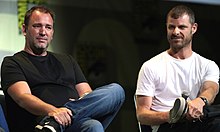
South Park creators Trey Parker (left) and Matt Stone continue to do most of the writing, directing and voice acting on the show. Parker and Stone met in film class at the University of Colorado in 1992 and discovered a shared love of Monty Python, which they often cite as one of their primary inspirations.[43] They created an animated short entitled The Spirit of Christmas.[27] The film was created by animating construction paper cutouts with stop motion, and features prototypes of the main characters of South Park, including a character resembling Cartman but named "Kenny", an unnamed character resembling what is today Kenny, and two near-identical unnamed characters who resemble Stan and Kyle. Fox Broadcasting Company executive and mutual friend Brian Graden commissioned Parker and Stone to create a second short film as a video Christmas card. Created in 1995, the second The Spirit of Christmas short resembled the style of the later series more closely.[44] To differentiate between the two homonymous shorts, the first short is often referred to as Jesus vs. Frosty, and the second short as Jesus vs. Santa. Graden sent copies of the video to several of his friends, and from there it was copied and distributed, including on the internet, where it became one of the first viral videos.[27][11]
As Jesus vs. Santa became more popular, Parker and Stone began talks of developing the short into a television series about four children residing in the fictional Colorado town of South Park. Fox eagerly agreed to meet with the duo about the show's premise, having prided itself on edgier products such as Cops, The Simpsons, and The X-Files. However, during the meeting at the Fox office in Century City, disagreements between the two creators and the network began to arise, mainly over the latter's refusal to air a show that included a supporting talking stool character named Mr. Hankey. Some executives at 20th Century Fox Television (which was to produce the series) agreed with its then-sister network's stance on Mr. Hankey and repeatedly requested Parker and Stone to remove the character in order for the show to proceed. Refusing to meet their demands, the duo cut ties with Fox and its sister companies all together and began shopping the series somewhere else.[45][46][47]
The two then entered negotiations with both MTV and Comedy Central. Parker preferred the show be produced by Comedy Central, fearing that MTV would turn it into a kids show.[48] When Comedy Central executive Doug Herzog watched the short, he commissioned for it to be developed into a series.[27][49] Parker and Stone assembled a small staff and spent three months creating the pilot episode "Cartman Gets an Anal Probe".[50] South Park was in danger of being canceled before it even aired when the show fared poorly with test audiences, particularly with women. However, the shorts were still gaining more popularity over the Internet, and Comedy Central ordered a run of six episodes.[36][48] South Park debuted with "Cartman Gets an Anal Probe" on August 13, 1997.[51]
Production[edit]
Except for the pilot episode, which was produced using cutout animation, all episodes of South Park are created with the use of software, primarily Autodesk Maya.[52] As opposed to the pilot, which took three months to complete,[53] and other animated sitcoms, which are traditionally hand-drawn by companies in South Korea in a process that takes roughly eight to nine months,[27][35] individual episodes of South Park take significantly less time to produce. Using computers as an animation method, the show's production staff were able to generate an episode in about three weeks during the first seasons.[54] Now, with a staff of about 70 people, episodes are typically completed in one week,[27][34][35] with some in as little as three to four days.[55][56][57] Nearly the entire production of an episode is accomplished within one set of offices, which were originally at a complex in Westwood, Los Angeles, California and are now part of South Park Studios in Culver City, California.[49][53] Parker and Stone have been the show's executive producers throughout its entire history.[58] Debbie Liebling, who was Senior Vice President of original programming and development for Comedy Central, also served as an executive producer during the show's first five seasons, coordinating the show's production efforts between South Park Studios and Comedy Central's headquarters in New York City.[59][60] During its early stages, finished episodes of South Park were hastily recorded to D-2 to be sent to Comedy Central for airing in just a few days' time.[61] Each episode used to cost $250,000.[62]
Writing[edit]

The Border Patrol raid during the Elián González affair is referenced in "Quintuplets 2000", which aired within the same week the event occurred. Scripts are not written before a season begins.[63] Production of an episode begins on a Thursday, with the show's writing consultants brainstorming with Parker and Stone. Former staff writers include Pam Brady, who has since written scripts for the films Hot Rod, Hamlet 2 and Team America: World Police (with Parker and Stone), and Nancy Pimental, who served as co-host of Win Ben Stein's Money and wrote the film The Sweetest Thing after her tenure with the show during its first three seasons.[64][65] Television producer and writer Norman Lear, an alleged idol of both Parker and Stone, served as a guest writing consultant for the season seven (2003) episodes "Cancelled" and "I'm a Little Bit Country".[63][66][67] During the 12th and 13th seasons, Saturday Night Live actor and writer Bill Hader served as a creative consultant and co-producer.[68][69][70]
After exchanging ideas, Parker will write a script, and from there the entire team of animators, editors, technicians, and sound engineers will each typically work 100–120 hours in the ensuing week.[50] Since the show's fourth season (2000), Parker has assumed most of the show's directorial duties, while Stone relinquished his share of the directing to focus on handling the coordination and business aspects of the production.[27][71] On Wednesday, a completed episode is sent to Comedy Central's headquarters via satellite uplink, sometimes just a few hours before its air time of 10 PM Eastern Time.[27][72]
Parker and Stone state that subjecting themselves to a one-week deadline creates more spontaneity amongst themselves in the creative process, which they feel results in a funnier show.[27] The schedule also allows South Park to both stay more topical and respond more quickly to specific current events than other satiric animated shows.[10][73] One of the earliest examples of this was in the season four (2000) episode "Quintuplets 2000", which references the United States Border Patrol's raid of a house during the Elián González affair, an event which occurred only four days before the episode originally aired.[74] The season nine (2005) episode "Best Friends Forever" references the Terri Schiavo case,[25][34] and originally aired in the midst of the controversy and less than 12 hours before she died.[35][75] A scene in the season seven (2003) finale "It's Christmas in Canada" references the discovery of dictator Saddam Hussein in a "spider hole" and his subsequent capture, which happened a mere three days prior to the episode airing.[76] The season 12 (2008) episode "About Last Night..." revolves around Barack Obama's victory in the 2008 presidential election, and aired less than 24 hours after Obama was declared the winner, using segments of dialogue from Obama's real victory speech.[77]
On October 16, 2013, the show failed to meet their production deadline for the first time ever, after a power outage on October 15 at the production studio prevented the episode, season 17's "Goth Kids 3: Dawn of the Posers", from being finished in time. The episode was rescheduled to air a week later on October 23, 2013.[78]
Animation[edit]
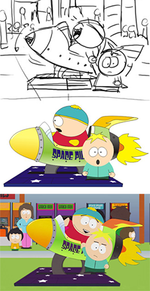
The various stages of production (from top to bottom): the storyboard sketch, the CorelDRAW props with stock character models, and a frame from the fully rendered episode, "Super Fun Time" The show's style of animation is inspired by the paper cut-out cartoons made by Terry Gilliam for Monty Python's Flying Circus, of which Parker and Stone have been lifelong fans.[48][11][79] Construction paper and traditional stop motion cutout animation techniques were used in the original animated shorts and in the pilot episode. Subsequent episodes have been produced by computer animation, providing a similar look to the originals while requiring a fraction of the time to produce. Before computer artists begin animating an episode, a series of animatics drawn in Toon Boom are provided by the show's storyboard artists.[50][80]
The characters and objects are composed of simple geometrical shapes and primary and secondary colors. Most child characters are the same size and shape, and are distinguished by their clothing, hair and skin colors, and headwear.[17] Characters are mostly presented two-dimensionally and from only one angle. Their movements are animated in an intentionally jerky fashion, as they are purposely not offered the same free range of motion associated with hand-drawn characters.[10][53][81] Occasionally, some non-fictional characters are depicted with photographic cutouts of their actual head and face in lieu of a face reminiscent of the show's traditional style. Canadians on the show are often portrayed in an even more minimalist fashion; they have simple beady eyes, and the top halves of their heads simply flap up and down when the characters speak.[38]
When the show began using computers, the cardboard cutouts were scanned and re-drawn with CorelDRAW, then imported into PowerAnimator, which was used with SGI workstations to animate the characters.[50][53] The workstations were linked to a 54-processor render farm that could render 10 to 15 shots an hour.[50] Beginning with
Futurama iPod – Unofficial
Futurama iPod – Unofficial theme by crazEyez
Download: FuturamaiPod.p3t
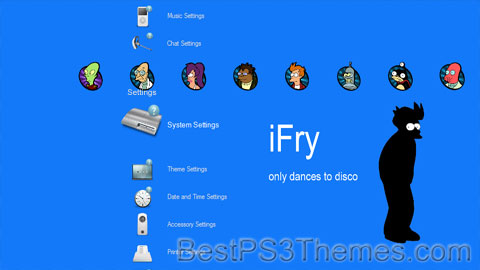
(3 backgrounds)
P3T Unpacker v0.12
Copyright (c) 2007. Anoop Menon
This program unpacks Playstation 3 Theme files (.p3t) so that you can touch-up an existing theme to your likings or use a certain wallpaper from it (as many themes have multiple). But remember, if you use content from another theme and release it, be sure to give credit!
Download for Windows: p3textractor.zip
Instructions:
Download p3textractor.zip from above. Extract the files to a folder with a program such as WinZip or WinRAR. Now there are multiple ways to extract the theme.
The first way is to simply open the p3t file with p3textractor.exe. If you don’t know how to do this, right click the p3t file and select Open With. Alternatively, open the p3t file and it will ask you to select a program to open with. Click Browse and find p3textractor.exe from where you previously extracted it to. It will open CMD and extract the theme to extracted.[filename]. After that, all you need to do for any future p3t files is open them and it will extract.
The second way is very simple. Just drag the p3t file to p3textractor.exe. It will open CMD and extract the theme to extracted.[filename].
For the third way, first put the p3t file you want to extract into the same folder as p3textractor.exe. Open CMD and browse to the folder with p3extractor.exe. Enter the following:
p3textractor filename.p3t [destination path]Replace filename with the name of the p3t file, and replace [destination path] with the name of the folder you want the files to be extracted to. A destination path is not required. By default it will extract to extracted.filename.
Calimero
Calimero theme by Louxx
Download: Calimero.p3t
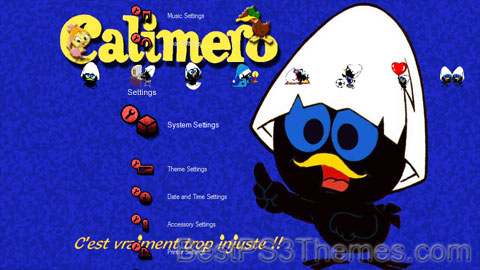
(3 backgrounds)
| Calimero | |
|---|---|
| Calimero character | |
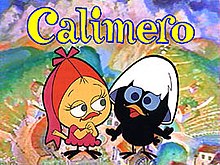 Calimero poster showing two of the main characters. | |
| First appearance | Carosello |
| Created by | Nino Pagot Toni Pagot Ignazio Colnaghi |
| Voiced by | Ignazio Colnaghi Davide Garbolino (2013-present) |
| In-universe information | |
| Species | Chick |
| Gender | Male |
| Origin | Italy |
| Calimero | |
| カリメロ (Karimero) | |
|---|---|
| Anime television series | |
| Directed by | Yugo Serikawa |
| Studio | Organizzazione Pagot Toei Animation |
| Original network | RAI (1963–1972) NET (now TV Asahi) (1972–1975) |
| Original run | July 14, 1963 – September 30, 1975 |
| Episodes | 47 |
| Anime television series | |
| Directed by | Tsuneo Tominaga, Shigeru Ueda |
| Music by | Junnosuke Yamamoto |
| Studio | Telescreen |
| Original network | TV Tokyo |
| Original run | October 15, 1992 – September 9, 1993 |
| Episodes | 52 |
| Anime television series | |
| Studio | Gaumont Animation |
| Original network | TF1, TV Tokyo, Rai 2 |
| English network | |
| Original run | October 7, 2013 – September 25, 2016 |
| Episodes | 104 |
Calimero is an animated television series about a charming but hapless anthropomorphized chicken; the only black one in a family of yellow chickens.[1] He wears half of his egg shell still on his head. Calimero originally appeared on the Italian television show Carosello on July 14, 1963, and soon became a popular icon in Italy.
The characters were created by the animation studio Organizzazione Pagot and originated as a series of animated advertisements for Miralanza AVA soap products shown throughout Italy. The creators of the main character were Nino Pagot, Toni Pagot and Ignazio Colnaghi.[2] At the end of each episode, it turns out that Calimero is not actually black, but only very dirty, and becomes white after being washed by the advertised soap products.
The characters were later licensed in Japan as an anime series twice, titled Calimero (カリメロ, Karimero). The first was made by Toei Animation and ran from October 15, 1972, to September 30, 1975; the second, with new settings and characters, was made in 1992. Altogether, 99 Japanese episodes were made (47 in the 1972 Toei series, and 52 in the 1992 Toei series). The series mostly consists of the many adventures of Calimero and his friends as they solve mysteries and make documentaries. However, their adventures usually get them into quite a bit of trouble. The second series was never renewed for a second season. English dubbed versions for the first two anime series were never officially released, though dubbed pilot episodes do exist. However, the series did come out in other languages. The original 1970s shorts and the third CGI series were released in English, however. The first series was also broadcast on European networks such as TROS (The Netherlands), ZDF and RTL II (Germany) or TVE (Spain).
A third animation series about the character, in computer animation, premiered in TF1 in 2013. The production team includes France’s Gaumont Animation, rights owner Calidra, Italy’s Studio Campedelli and Japanese partners TV Tokyo and Kodansha. The series also aired on several other TV channels, including on Disney Junior in the United Kingdom and Australia.[2]
Characters[edit]
1974 series[edit]
- Calimero (カリメロ) – The hero of the show. Calimero is voiced by Katsue Miwa in Japanese and Uti Hof in English.[3][4]
- Priscilla (プリシラ) – Calimero's girlfriend, a shy bird with common sense. Priscilla is voiced by Michiko Nomura.[3]
- Peter Jobatta (ピーター ジョバッタ, Papero Piero in the Italian original spot) – Peter is voiced by Kaneta Kimotsuki.[3]
- Buta (ブータ) – Buta is voiced by Masako Nozawa.[3]
- Deppa (デッパ) – Deppa is voiced by Sachiko Chijimatsu.[3]
- Calimero's mother (カリメロの母, Cesira in the Italian original spot) – Calimero's mother is voiced by Masako Nozawa.[3]
- Calimero's father (カリメロの父, Gallettoni in the Italian original spot) – Calimero's father is voiced by Ken'ichi Ogata.[3]
- Mr. Owl (フクロウ先生) – Mr. Owl is voiced by Jōji Yanami.[3]
1992 series[edit]
- Calimero – Calimero is voiced by Shinobu Adachi in Japanese and Liz MacRae in English.[3]
- Priscilla – Priscilla is voiced by Akemi Okamura in Japanese and Aimée Castle in English.[3]
- Peter (ピーター) – Peter is voiced by Akirasa Ōmori in Japanese and Rick Jones in English.[3]
- Giuliano (Peanut in English dub pilot) (ジュリアーノ) – Giuliano is voiced by Yūji Ueda.[3]
- Susie (スージー) – a wealthy girl duck. Susie is voiced by Natsumi Sasaki.[3]
- Roshita (ロシータ) – Roshita is voiced by Hiroko Kasahara.[3]
- Pepe (ペペ) – Pepe is voiced by Masashi Ebara.[3]
2013 series[edit]
- Calimero - Voiced by: Rachel Berger (English) / Fanny Bloc (French) / Ayaka Asai (Japanese)
- Priscilla -Voiced by: Naïke Fauveau (French) / Rumi Ōkubo (Japanese)
- Giuliano (Valeriano in UK English dub)- Voiced by Georges de Vitis (French) / Kokoro Kikuchi (Japanese)
- Peter (Pierrot in UK English dub) - Voiced by: Pascal Sellem (French) / Tōru Sakurai (Japanese)
- Susie - Voiced by: Ren Kato (Japanese)
- Pepe - Voiced by: Tōmoyuki Maruyama (Japanese)
Mobile game[edit]
A mobile game titled Calimero's Village was released for iOS and Android in 2015 by BulkyPix.
Impact in popular culture[edit]
The main character in the anime series has had a lasting impact in the vocabulary of some countries, either because of his looks, with an egg shell on his head, or because of his frequent complaining about being unfairly treated by others:
- Calimero is the name and subject of a Welsh language song by the band Super Furry Animals[5]
- French singer Brigitte Fontaine collaborated with the band Stereolab on a song of the same name[6]
- In the Netherlands and Belgium, the term "Calimerocomplex" is used to denote people who are staunchly convinced that their position as an underdog is due to their smaller size, either literally or symbolically, which covers up for their own shortcomings. Often the character's lines from the show are cited, "They are big and I is [sic] small and that is not fair, oh no!" (translated back from Dutch, with intentional error).[7]
- The slang nickname during the 1970s and 1980s for military policemen in the Israeli Army was Calimero, due to their egg-shaped white helmet; the same was the case in Spain,[8] where calimero was also a name for a type of helmet for motorbikers.[9]
- In parts of Yugoslavia, the Polski Fiat 126p was nicknamed Kalimero in reference to the character.
- Italian luxury fashion house Bottega Veneta introduced the "Kalimero" bucket bag in 2022, taking inspiration from the bindle that the character carries.[10]
References[edit]
- ^ Crump, William D. (2019). Happy Holidays—Animated! A Worldwide Encyclopedia of Christmas, Hanukkah, Kwanzaa and New Year's Cartoons on Television and Film. McFarland & Co. p. 38. ISBN 9781476672939.
- ^ a b McLean, Tom (January 27, 2014). "New 'Calimero' Series to Premiere on France's TF1".
- ^ a b c d e f g h i j k l m n o カリメロアニメ紹介 (in Japanese). Chara Pit. Retrieved December 17, 2010.
- ^ "Uti Hof Blanchard Obituary 2022". Goff Mortuary. Retrieved March 25, 2024.
- ^ The lyrics in Welsh say "Calimero wyt ti'n gwisgo wy ar dy ben" (Calimero you're wearing an egg on your head)
- ^ The lyrics in French say "Je suis Caliméro, le vilain poussin noir" ("I'm Calimero, the naughty black chicken").
- ^ Otte, Anja (May 5, 2009). "Calimero". Flanders Today. Archived from the original on September 17, 2016. Retrieved June 6, 2012.
- ^ Juan Gómez Capuz: El argot de los soldados de reemplazo: aspectos lexico-semánticos, lexicogenésicos y fraseológicos. (In Spanish)
- ^ ABC newspaper: Adiós al «casco calimero» (In Spanish)
- ^ "Bottega Veneta's Matthieu Blazy Is Taking Artisanal Craft in a New Direction". Vogue. August 23, 2022. Retrieved March 8, 2023.
External links[edit]
- Official website
- Calimero's first commercial (1963)
- Calimero (anime) at Anime News Network's encyclopedia
- Calimero 1992 (anime) at Anime News Network's encyclopedia





